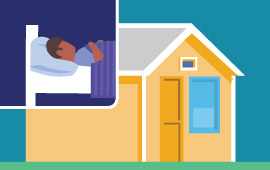
CDC
Authors: Zachary J. Madewell PhD, Yang Yang PhD, Ira M. Longini Jr PhD, et al.
Contact hours: 1.5
Expiration date: December 31, 2021
Course price: $12
Course Summary
The coronavirus disease 2019 (COVID-19) pandemic is caused by severe acute respiratory syndrome coronavirus 2 (SARS-CoV-2), which is spread via direct or indirect contact with infected people via infected respiratory droplets or saliva, fomites, or aerosols. Crowded indoor environments with sustained close contact and conversations, such as households, are a particularly high-risk setting.
The World Health Organization China Joint Mission reported human-to-human transmission in China largely occurred within families, accounting for 78% to 85% of clusters in Guangdong and Sichuan provinces. Stay-at-home orders reduced human mobility by 35% to 63% in the United States, 63% in the United Kingdom, and 54% in Wuhan, relative to normal conditions, which concomitantly increased time at home. Modeling studies demonstrated that household transmission had a greater relative contribution to the basic reproductive number after social distancing (30%-55%) than before social distancing (5%-35%). While current U.S. Centers for Disease Control and Prevention recommendations are to maintain 6 feet of distance from a sick household member, this may be difficult to achieve in practice and not be fully effective.
The household secondary attack rate characterizes virus transmissibility. Studies can collect detailed data on type, timing, and duration of contacts and identify risk factors associated with infectiousness of index cases and susceptibility of contacts. Our objective was to estimate the secondary attack rate of SARS-CoV-2 in households and determine factors that modify this parameter. We also estimated the proportion of households with index cases that had any secondary transmission. Furthermore, we compared the SARS-CoV-2 household secondary attack rate with that of other severe viruses and with that to close contacts for studies that reported the secondary attack rate for both close and household contacts.
Citation: Madewell ZJ, Yang Y, Longini IM, et al. (2020). Household Transmission of SARS-CoV-2: A Systematic Review and Meta-analysis. JAMA Network Open. Doi:10.1001/jamanetworkopen.2020.31756.
Criteria for Successful Completion
A score of 80% or higher on the post test, a completed evaluation form, and payment where required. No partial credit will be awarded.
Accreditation
To find specific accreditations or approvals, click here.
Course Objectives
When you finish this course you will be able to:
- Name 2 obstacles to reducing vulnerability to COVID-19 in households.
- Explain family secondary attack rate and 3 relationships that contribute to it.
- Cite 4 prevention strategies suggested by this overview of household transmissions.
